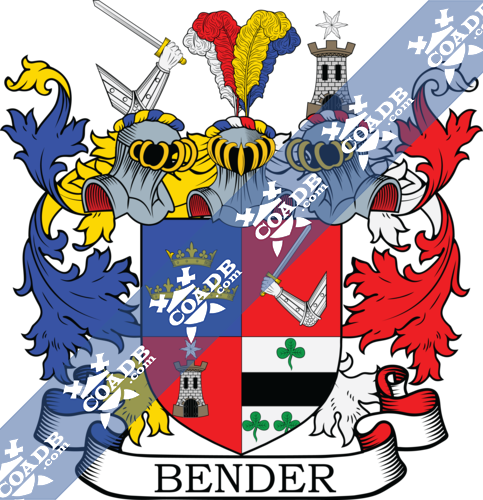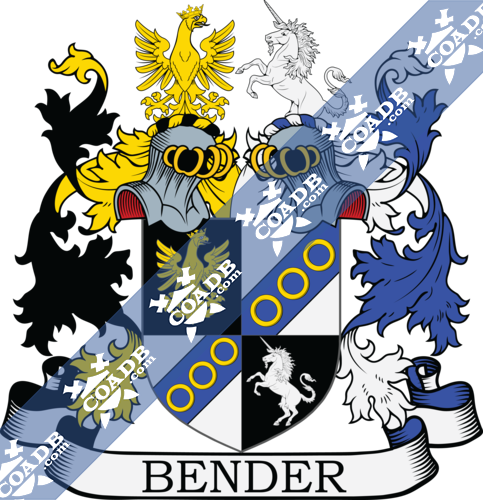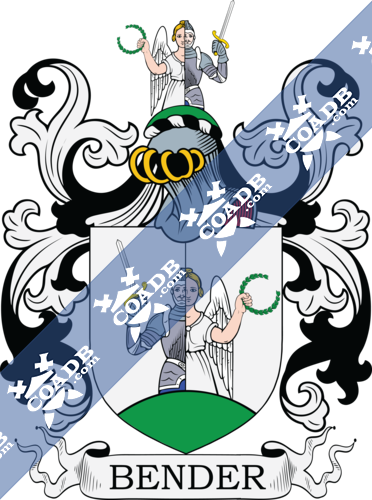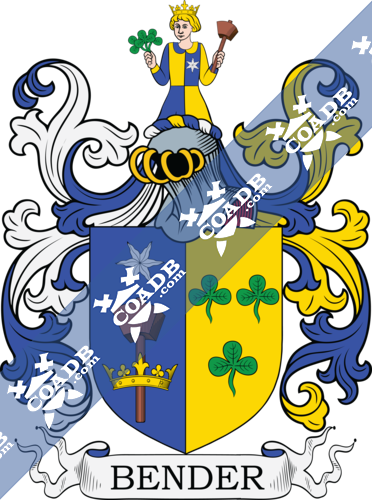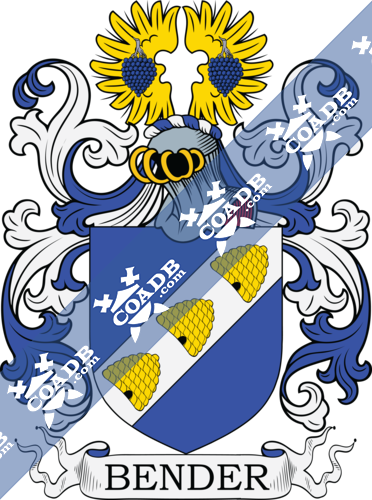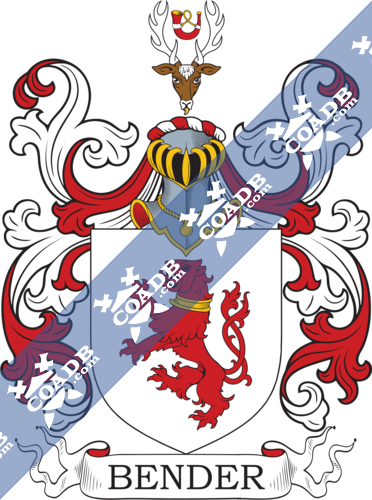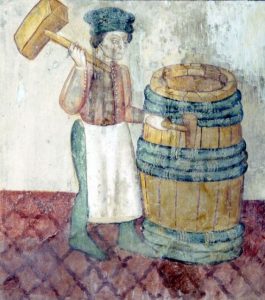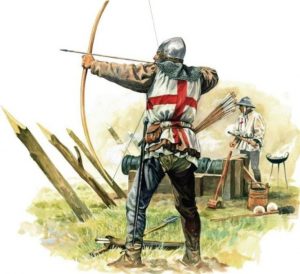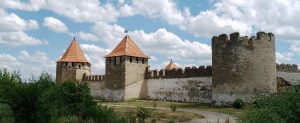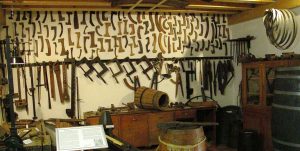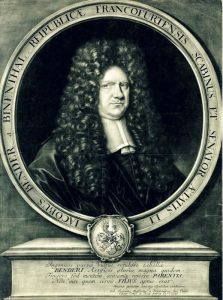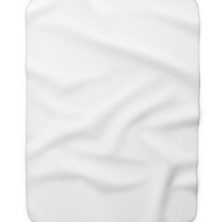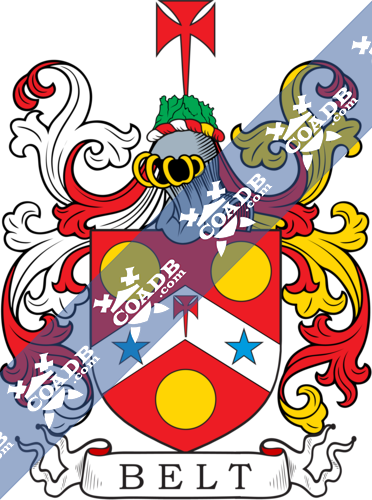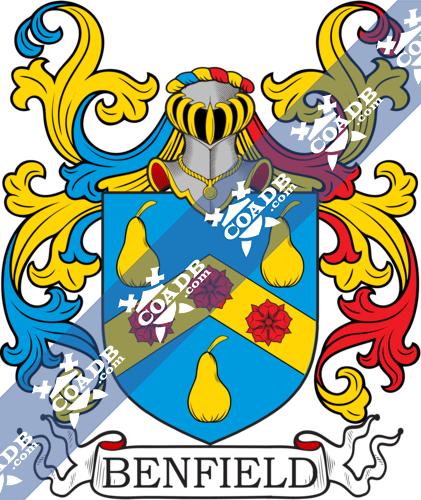Bender Family Crest, Coat of Arms and Name History
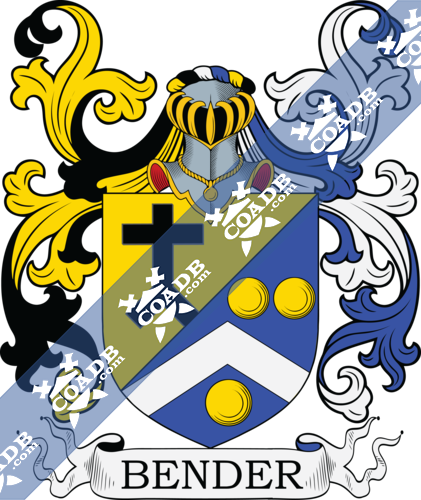
Bender Coat of Arms Gallery
Don’t know which Coat of Arms is yours?
We can do a genealogical research. Find out the exact history of your family!
Learn MoreSurname Name Meaning, Origin, and Etymology
This name has two origins, one German and another English. In Germany, it is a shorten version of the surname Fassbender, which is an occupational surname for a cooper, a person who made barrels. In England, it derives from the Old English word bendan, meaning “to bend (the bow)” and hence is most likely a metonymic occupational name for an archer (similar to the last name Benbow). One source asserts the name was first found in Baden, a historical territory in southern Germany. Less commonly, it can be a locational name for a person who came from a city in Moldova named Bender on the banks of the Dniester river. One source asserts most of the Benders in the United States were Pennsylvania Dutch, a term coined by the early American/English settlers to refer to German immigrants, using the German word for German people Deutsch, which eventually was corrupted to Dutch. Another source states: “Bender, an Amish Mennonite family name, is first recorded in the Amish community near Waldeck (later near Marburg) in Hesse-Cassel, Germany in about 1790”.
Spelling Variations
Common spelling variants or names with similar etymologies include Bander, Bennder, Bandder, Bendder, and Bannder.
Popularity & Geographic Distribution
The last name Bender ranks 821st in popularity in terms in the United Status as of the 2000 Census. The name is significantly less common in England, where it ranks only 8,010. The name ranks particularly high in the following nine states: Pennsylvania, Ohio, Wisconsin, Indiana, Nebraska, Iowa, Montana, North and Dakota. In Germany, the last name Bender is the 154th most frequent name. It is particularly frequent in Cologne, Frankfurt, and Munich. In Switzerland and Austria, it ranks 767th and 3,340th, respectively, in terms of commonness.
Early Bearers of the Surname
The earliest known bearer of this surname documented to history was Balthasar Bender who was born in Germany around 1560. He married Catharina Menger and they had a son named Ansett (Hans) Bender who was born in Eschelbach, Heidelberg, Baden-Wurerttemberg. He married twice, to women named Margaret and Anna, whose maiden names are unknown, and he had four issue: Micheal, Anna, Nicoclaus, and Margretha. His son Micheal was for in the same town in 1644. He married Ursula Rucker and they had seven children with her: Johann Jacob, Georg Adam, Anna, Maria Eva, Johann Georg, Johann, and Michel. His son Johann George was born in the same town in 1694. He married Anna Ursula and had the following issue with her: Georg Caspar, Anna Maria Helena, Maria Helena, Johann Georg, Anna Ursula, and Georg Clauss. His son Johann Georg Bender was born in 1716 in Eschelbach, Germany and he married Maria Elizabeth Lutz with whom he had the following children: Maria Catharina, Maria Elisabeth, Johann Caspar, Maria Barbara, Johann Christoph, Anna Dorothea, Maria Helen.
A one Johann Bender was born around 1620. He married a woman named Helena with whom he had two sons: Leonhard and Michael. His son Leonhard was born in Kleinostheim, Bavaria and he married Anna Eizenhöfer, and they had ten children together: Johann, Margaretha, Andreas, Johann Georg, Sebastian, Eva Margaretha (Schohe), Maria Margaretham, Johann Adam, Anna Maria, and Adam Peter. His son Johann was born between 1649-1703 in the same town. He married Katharina Hauck, and he had the following children with her: Johann Michael, Andreas, Adam Peter, Johann Heinrich, Maria Eva, and Johann. His son Johann Michael Bender was born in 1703 in Kleinostheim and he married Anna Margarthea Möller, and he had the following issue: Valentin, Margaretha, Johann Heinrich, Johann Martin, and Melchior.
Johann or John Bender was born in Wurttemberg, Germany in the first half of the nineteenth century. He married Sophia Pfeiffer and had three issue with her: Clara, Helena, and Friedrich. His son Friedrich or Fred Bender was born in the same state in 1863. He married Auguste Bendig and he had the following issue: Clara, Elisabeth, Helen (Neff), Herbert, Charles, Edith, Bertha (Thompson), Clarence, Emma Louise, Laura Henriette (Heisel), Edward, John Frederick, and Elmer Wilhelm. His son Clarence (nickname Sputzy) was born in Pittsburgh, PA in 1903. He married Marcella Hilderhoff and they had the following issue together: Gloria A. Rieder, Clarence George, Charles Frederick, Donald Nicholas, and Howard E., and William L. Bender.
John George (or Johann) Bender was born in Russia in 1813. He married Christina Margaretha Mauch in 1831 and Russia. He went to the United States. He had a son named John. John was born in 1836 in Worms, Odessa and he married Margaretha Bender and had a son with her named Wilhelm. Wilhelm Bender was born in Odessa and he married Barbara Reidinger there in 1892. Before his death in 1939 in Hursfield South Dakota, he had the following issue: Eva (Patzer), Jacob, Wilheml, Christine (Lausch), Rosi (Brown), John, Emma (Baier), and Wola Pauldina (Widiger).
Marianna Bender was born in Steinberg, Ukraine in 1879. She married Anton L. Lauinger and she went to North Dakota. She had a daughter named Theresa Frances in 1900, who married Ralf Steven Berger.
Early American and New World Settlers
Early settlers in colonial American bearing this name include Anna Maria, George, and Henrig who settled in New York in 1709. Early settlers in Canada include Dennis Bender and George Bender, United Empire Loyalists, people from the American Colonies who remained loyal to the British Crown during the American Revolution, who arrived in Cornwall around 1783. One of the earliest settlers in New Zealand bearing this last name was Simon Bender, who came aboard the Berar in 1865 and settled in Wellington.
Matthus Bender, and with wife Carharina, daughters Catharina, and sons Alexander and Johann Georg immigrated to Pennsylvania in between 1713 and 1727. A one Mathias Bender (Painter) (born circa 1660) came to Philadelphia in the 1720s.
The book Thirty Thousand Immigrants names in PA by Rupp states the following: “The Benders are prominent and numerous in Lancaster County and Eastern Pennsylvania.About this time Matthias Bender or Binder a Mennonite minister of Wurtenburg in Germany, was arrested and taken to Stuttgart prison on account of his faith, and later imprisoned in chains.He was examined and threatened by the doctors of theology, the representatives of the Prince and by the abbott.He was then sent to the castle of Hohenwithing and remained two years, when in 1576 the castle was burned to the ground.He was then released because of his brave conduct about the fire”.
Grantees
We have 9 coats of arms for the Bender surname depicted here. The first 8 blazons are from Armorial General published in 1861 by the famous genealogist/heraldist Johannes Baptisa Rietstap. The 9th Bender Family Crest on this page is British, as it is from Bernard Burke’s book The General Armory of England, Ireland, and Scotland, which was published in 1848. The bottom of this page contains the blazons (in French and translated to English), and in many instances contains some historical, geographical, and genealogical about where coat of arms was found and who bore it.
Notables
There are hundreds of notable people with the Bender surname. This page will mention a handful. Famous people with this last name include: 1) Jack Bender (1949) who was an American television and firm director best known for three cult favorite shows: The Sopranos, Lost, and Game of Thrones, 2) Austin Letheridge Bender (1916-1980) who was the mayor of Chattanooga, Tennessee from 1961-1971, a veteran of World War II who obtained the rank of Captain, 3) Chester R. Bender (1914-1996) who was the fourteenth Commandant of the United States Coast Guard, 4) Riley Alvin Bender (1890-1973) who was a US businessmen who is best known for his three bids for the presidential nomination of the Republican Party in elections of 1944, 1948, and 1952, 5) Hans Bender (1907-1991) was a German lecturer from Freiburg on the topic of parapsychology, and 6) Manfred Bender (1966) who is a German football manager and former player from Munich who most recently managed Austria Klagenfurt.
Blazons & Genealogy Notes
1) Styrie – Parti au 1 d’argent à un chevalier issant armé au naturel tenant une épée mouv du parti au 2 d’argent à un ange issant de carnation la dalmatique d’argent l’aile abaissée mouv du parti et tenant une couronne de laurier de sinople lesdites figures réunies mouv d’un tertre de sinople en pointe brochant sur le parti Casque couronné Cimier les meubles de l’écu sauf que l’ange se trouve à dextre et le chevalier à senestre Lambrequin d’argent et de sable. English: Per pale 1st argent an armoured knight issuant proper holding a sword coming from the the partition 2nd argent an angel issuant carnation the tunic argent the wings lowered coming from the partition and holding a crown of laurels vert the aforementioned figures combined coming from a hillock vert in base covering over the partition Crowned with a helmet Crest: the charges of the shield except that the angel is found to the dexter and the knight to the sinister Mantling: argent and sable.
2) Valais – Taillé au 1 d’or à une croix alésée de sable le pied fendu en chevron la branche senestre dudit chevron mouv du taillé au 2 d’azur au chevron d’argent acc de trois besants d’or. English: Party per bend sinister a cross couped sable the foot cut in a chevron the sinister branch of the chevron coming from the partition 2nd azure a chevron argent surrounded by three bezants or.
3) Nördlingen (Bavière) – D’azur à une sirène de carnation à deux queues de sable qu’elle tient de ses mains Cimier la sirène. English: Azure a mermaid carnation with two tails sable which she holds in her hands Crest: the mermaid.
4) Bade – (Barons, 1 janv. 1782) – Écartelé au 1 d’azur à trois couronnes mal-ordonnées d’or au 2 de gueules au senestrochère armé d’argent tenant une épée du même garnie d’or au 3 de gueules à une tour au naturel ouverte et ajourée de sable acc au point du chef d’une étoile d’argent au 4 d’argent à la fasce de sable acc de trois trèfles de sinople 1 en chef et 2 en pointe Trois casques couronnés Cimiers 1° le bras du 2 contourné posé sur le coude 2° quatre plumes d’autruche d’argent de gueules d’or et d’azur 3° les meubles du 3 Lambrequin à dextre d’or et d’azur à senestre d’argent et de gueules. English: Quarterly 1st azure three crowns (disordered) 1 and 2 or 2 gules an armoured left arm argent holding a sword of the same hilt and pommell or 3rd gules a tower proper openings and portcullis sable accompanied by an etoile argent in centre chief 4th argent a fess sable surrounded by three trefoils vert 1 in chief and 2 in base Crowned with three helmets Crest: 1st the arm of the 2nd (quarter) reversed placed on the elbow 2nd four ostrich feathers argent, gules, or and azure 3rd the charges of the 3rd (quarter) Mantling: to the dexter or ans azure to the sinister argent and gules.
5) Bade – (Nob. du St.-Empire, 29 nov. 1708) – Parti au 1 d’azur à un maillet au naturel posé en pal le manche passé dans une couronne à l’antique d’or le maillet acc en chef d’une étoile d’argent au 2 d’or à trois trèfles de sinople Casque couronné Cimier un jeune homme issant chevelé d’or couronné à l’antique du même tenant de sa main dextre trois trèfles de sinople et de sa senestre un maillet au naturel habillé d’un écartelé d’or et d’azur la poitrine ch à senestre d’une étoile d’argent sur l’azur le bras dextre paré d’azur rebrassé d’or et le bras senestre paré d’or rebrassé d’azur au rabat parti d’azur et d’or Lambrequin à dextre d’argent et d’azur à senestre d’or et d’azur. English: Per pale 1st as a mallet proper in pale the shaft passing through an antique crown or the mallet accompanied by in chief an etoile argent 2nd or three trefoils vert Crowned with a helmet Crest: a young man issuant long haired or wearing an antique of the same holding in his dexter hand three trefoils vert and in his sinister hand a mallet proper (the man) dressed quartered or and azure the chest charged with to the sinister an etoile argent on the azure the dexter arm adorned azure bordered or and the sinister arm adorned or bordered azure folds per pale azure and or Mantling: to the dexter argent and azure to the sinister or and azure.
6) de Bienenthal – Francfort-s/Main – (An., 1658. M. ét. en 1853) – D’azur à la barre d’argent ch de trois ruches d’abeilles d’or Casque couronné Cimier un vol d’or chaque aile ch d’une grappe de raisins au naturel Lambrequin d’argent et d’azur. English: Azure a bend sinister argent charged with three beehives or Crowned with a helmet Crest: a pair of wings or each wing charged with a bunch of grapes proper Mantling: argent and azure.
7) de Laytha – Autriche – (Chevaliers du St.-Empire, 1745) – Écartelé aux 1 et 4 de sable à l’aigle d’or couronnée du même celle du 1 contournée aux 2 et 3 d’argent à la barre d’azur ch de trois annelets d’or au 4 de sable à la licorne saillante d’argent Deux casques couronnés Cimiers 1° l’aigle du 1 Lambrequin d’or et de sable 2° licorne du 4 issante Lambrequin d’argent et d’azur. English: Quarterly 1st & 4th sable an eagle or crowned of the same that on the 1st reversed 2nd & 3rd argent a bend sinister azure charged with three annulets or (alternatively) 4th sable a unicorn rampant argent Crowned with two helmets Crest: 1st the eagle of the 1st (quarter) Mantling: or and sable 2nd the unicorn of the 4th issuant Mantling: argent and azure.
8) de Laytha – Autriche – (Barons, 1770) – Écartelé au 1 de sable à l’aigle d’or couronnée du même la tête contournée aux 2 et 3 de gueules à trois annelets d’or au 4 de sable à la licorne saillante d’argent A la rivière d’argent en fasce brochant sur l’écartelé Trois casques couronnés Cimiers 1° la licorne issante et contournée Lambrequin d’argent et de sable 2° l’aigle la tête tournée à dextre Lambrequin d’or et de sable 3° un vol à l’antique aux armes du 2 Lambrequin d’argent et de gueules Tenants deux sauvages de carnation couronnés de lierre armés de massues couverts de peaux de bêtes féroces au naturel. English: Quarterly 1st sable and eagle or crowned of the same the head to the sinister 2nd & 3rd gules three annulets or 4th sable a unicorn rampant argent, a river (bars wavy) argent in fess covering over the partition Crowned with three helmets Crest: 1st the unicorn issuant and reversed Mantling: argent and sable 2nd the eagle the head turned to the dexter Mantling: or and sable 3rd an ancient pair of wings with the arms of the 2nd (quarter) Mantling: argent and gules Supporters: two savages carnation crowned with ivy armed with clubs covered in the skins of fierce animals all proper.


